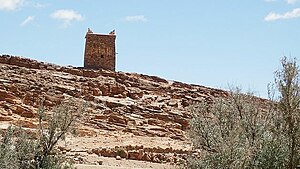Ait Kine
| Ait Kine | ||||
|---|---|---|---|---|
|
||||
| Basic data | ||||
| State : |
|
|||
| Region : | Souss-Massa | |||
| Province : | Tata | |||
| Coordinates | 29 ° 59 ′ N , 8 ° 13 ′ W | |||
| Residents : | 500 | |||
| Height : | 1050 m | |||
| Aït Kine - the townscape with a gate and watchtower | ||||
Aït Kine ( Taschelhit ⴰⵢⵜ ⴽⴽⵉⵏ ) is a date palm oasis with around 500 inhabitants in the center of the Anti-Atlas Mountains in the north of the Tata province in the northeast of the Souss-Massa region in Morocco .
location
The formerly fortified village ( ksar ) Aït Kine is located at an altitude of about 1050 m, about halfway (i.e. about 50 km each) between the small town of Igherm in the province of Taroudannt and the town of Tata in the province of the same name at one near the town of Tleta Day route towards the northeast branching off road (P1805).
Population, Economy and History
The inhabitants of the remote village are almost without exception of Berber descent; A regional dialect of the Taschelhit is spoken . One lives mainly as a self-sufficiency from the yields of the date palms and the fields in between, on which grain and vegetables (onions, beans, carrots) are grown. In the absence of written records, nothing is known about the history of the place; However, it can be assumed that in earlier times most of the families of the place moved with their sheep and goat herds to higher-lying and consequently cooler and greener mountain regions during the hot and dry summer months ( transhumance ), so that the place was largely deserted during this time was thus vulnerable. In contrast, the villagers tried to protect themselves with at least (previously possibly five) watchtowers, three of which still exist - two of them are on the southern edge of the village, the remains of a high wall between the two can be seen. The third tower is located outside on a hill because of the better view of the southern plain.
Attractions

- A partially reconstructed and now free-standing tower with a large gate was previously the only access to the village. With its stepped battlements and a three-part field decoration above the two outer round arches, it forms an unusually representative entrance to the site. In the inwardly graded fields there are window openings that illuminate the space behind and formerly used as a guardroom. Arches do not otherwise appear in traditional rural Berber architecture , which suggests inspiration from outside and a late dating of the gate to the 18th or 19th century.
- In the middle of the village is a three-storey storage castle ( agadir ) made of rammed earth and mixed with small stones , the old wooden entrance door of which is adorned with simple decorative carvings (including the diamond motifs ubiquitous in the Berber regions of Morocco). Behind the door are some benches for the gathering of the village elders. The large inner courtyard area is surrounded by 75 chambers - accessible via relocatable palm-trunk ladders and wooden platforms - in which food supplies (barley, dates, almonds, oil, etc.) and other possessions (weapons, tools, etc.) were kept. Some of the simple board doors to the storage chambers are still original; the more or less richly ornamented doors indicated the wealth of the respective owner. In the middle of the courtyard there is a covered cistern for the supply of drinking water in case of defense. On the outer walls, several slanted stones are joined together to form rows of triangles, etc., with an ornamental effect; one can assume, however, that these decorative patterns originally had mainly a disaster-warding ( apotropaic ) meaning. The imposing structure with a (preserved) corner tower was repaired in 2004 by the villagers, who still use the storage facility, partially modernized with cement and connected to the power grid. In 2012 the building was again restored with US money; the cement repairs were replaced by traditional materials, the cistern in the courtyard was covered with stone slabs, the walls facing the courtyard were covered with a layer of clay, which prevents the masonry from being washed out for a while. The notched timbers used to access the chambers on the upper floors have been restored; In addition, the wooden entrance door has been restored and the entrance portal returned to its original state.
- Remnants of a khetarra indicate the traditional irrigation system of the oasis.
- Surroundings
- On the hill to the northwest of the village, the ruins of another agadir are in a difficult-to-reach location.
- Another partially reconstructed watchtower stands on another rocky hilltop.
literature
- Herbert Popp, Mohamed Ait Hamza, Brahim El Fasskaoui: Les agadirs de l'Anti-Atlas occidental. Atlas illustré d'un patrimoine culturel du Sud marocain. Natural Science Society, Bayreuth 2011, ISBN 978-3-939146-07-0 .




